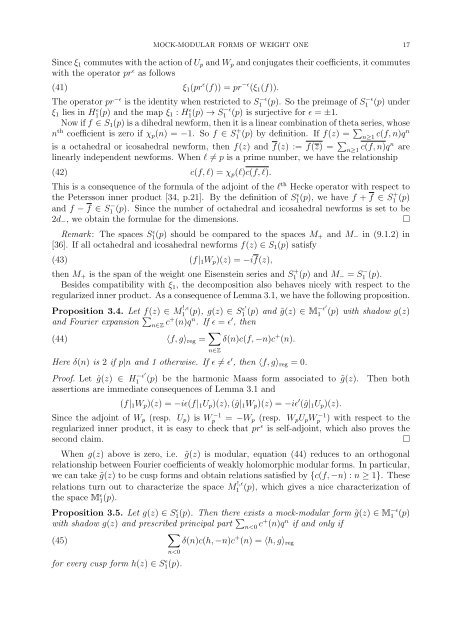Mock-modular forms of weight one - UCLA Department of Mathematics
Mock-modular forms of weight one - UCLA Department of Mathematics
Mock-modular forms of weight one - UCLA Department of Mathematics
Create successful ePaper yourself
Turn your PDF publications into a flip-book with our unique Google optimized e-Paper software.
MOCK-MODULAR FORMS OF WEIGHT ONE 17<br />
Since ξ 1 commutes with the action <strong>of</strong> U p and W p and conjugates their coefficients, it commutes<br />
with the operator pr ɛ as follows<br />
(41) ξ 1 (pr ɛ (f)) = pr −ɛ (ξ 1 (f)).<br />
The operator pr −ɛ is the identity when restricted to S1 −ɛ (p). So the preimage <strong>of</strong> S1 −ɛ (p) under<br />
ξ 1 lies in H1(p) ɛ and the map ξ 1 : H1(p) ɛ → S1 −ɛ (p) is surjective for ɛ = ±1.<br />
Now if f ∈ S 1 (p) is a dihedral newform, then it is a linear combination <strong>of</strong> theta series, whose<br />
n th coefficient is zero if χ p (n) = −1. So f ∈ S 1 + (p) by definition. If f(z) = ∑ n≥1<br />
c(f, n)qn<br />
is a octahedral or icosahedral newform, then f(z) and f(z) := f(z) = ∑ n≥1 c(f, n)qn are<br />
linearly independent new<strong>forms</strong>. When l ≠ p is a prime number, we have the relationship<br />
(42) c(f, l) = χ p (l)c(f, l).<br />
This is a consequence <strong>of</strong> the formula <strong>of</strong> the adjoint <strong>of</strong> the l th Hecke operator with respect to<br />
the Petersson inner product [34, p.21]. By the definition <strong>of</strong> S1(p), ɛ we have f + f ∈ S 1 + (p)<br />
and f − f ∈ S1 − (p). Since the number <strong>of</strong> octahedral and icosahedral new<strong>forms</strong> is set to be<br />
2d − , we obtain the formulae for the dimensions.<br />
□<br />
Remark: The spaces S ɛ 1(p) should be compared to the spaces M + and M − in (9.1.2) in<br />
[36]. If all octahedral and icosahedral new<strong>forms</strong> f(z) ∈ S 1 (p) satisfy<br />
(43) (f| 1 W p )(z) = −if(z),<br />
then M + is the span <strong>of</strong> the <strong>weight</strong> <strong>one</strong> Eisenstein series and S + 1 (p) and M − = S − 1 (p).<br />
Besides compatibility with ξ 1 , the decomposition also behaves nicely with respect to the<br />
regularized inner product. As a consequence <strong>of</strong> Lemma 3.1, we have the following proposition.<br />
Proposition 3.4. Let f(z) ∈ M !,ɛ<br />
1 (p), g(z) ∈ S ɛ′<br />
1 (p) and ˜g(z) ∈ M −ɛ′<br />
1 (p) with shadow g(z)<br />
and Fourier expansion ∑ n∈Z c+ (n)q n . If ɛ = ɛ ′ , then<br />
(44) 〈f, g〉 reg = ∑ n∈Z<br />
δ(n)c(f, −n)c + (n).<br />
Here δ(n) is 2 if p|n and 1 otherwise. If ɛ ≠ ɛ ′ , then 〈f, g〉 reg = 0.<br />
Pro<strong>of</strong>. Let ĝ(z) ∈ H −ɛ′<br />
1 (p) be the harmonic Maass form associated to ˜g(z). Then both<br />
assertions are immediate consequences <strong>of</strong> Lemma 3.1 and<br />
(f| 1 W p )(z) = −iɛ(f| 1 U p )(z), (ĝ| 1 W p )(z) = −iɛ ′ (ĝ| 1 U p )(z).<br />
Since the adjoint <strong>of</strong> W p (resp. U p ) is W −1<br />
p<br />
= −W p (resp. W p U p Wp<br />
−1 ) with respect to the<br />
regularized inner product, it is easy to check that pr ɛ is self-adjoint, which also proves the<br />
second claim.<br />
□<br />
When g(z) above is zero, i.e. ˜g(z) is <strong>modular</strong>, equation (44) reduces to an orthogonal<br />
relationship between Fourier coefficients <strong>of</strong> weakly holomorphic <strong>modular</strong> <strong>forms</strong>. In particular,<br />
we can take ˜g(z) to be cusp <strong>forms</strong> and obtain relations satisfied by {c(f, −n) : n ≥ 1}. These<br />
relations turn out to characterize the space M !,ɛ<br />
1 (p), which gives a nice characterization <strong>of</strong><br />
the space M ɛ 1(p).<br />
Proposition 3.5. Let g(z) ∈ S1(p). ɛ Then there exists a mock-<strong>modular</strong> form ˜g(z) ∈ M −ɛ<br />
1 (p)<br />
with shadow g(z) and prescribed principal part ∑ n
















